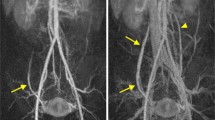Abstract
Purpose
The objective of this study is to assess the performance of qualitative and quantitative imaging features for the differentiation of deep venous thrombosis (DVT) from mixing artifact on routine portal venous phase abdominopelvic CT.
Methods
This retrospective study included 40 adult patients with a femoral vein filling defect on portal venous phase CT and a Duplex ultrasound (n = 36) or catheter venogram (n = 4) to confirm presence or absence of DVT. Two radiologists (R1, R2) assessed the femoral veins for various qualitative and quantitative features.
Results
60% of patients were confirmed to have DVT and 40% had mixing artifact. Features with significantly greater frequency in DVT than mixing artifact (all p ≤ 0.006) were central location (R1 90% vs. 28%; R2 96% vs. 31%), sharp margin (R1 83% vs. 28%; R2 96% vs. 31%), venous expansion (R1 48% vs. 6%, R2 56% vs. 6%), and venous wall enhancement (R1 62% vs. 0%; R2 48% vs. 0%). DVT exhibited significantly lower mean attenuation than mixing artifact (R1 42.1 ± 20.2 vs. 57.1 ± 23.6 HU; R2 43.6 ± 19.4 vs. 58.8 ± 23.4 HU, p ≤ 0.031) and a significantly larger difference in vein diameter compared to the contralateral vein (R1 0.4 ± 0.4 vs. 0.1 ± 0.2 cm; R2 0.3 ± 0.4 vs. 0.0 ± 0.1 cm, p ≤ 0.026). At multivariable analysis, central location and sharp margin were significant independent predictors of DVT for both readers (p ≤ 0.013).
Conclusion
Awareness of these qualitative and quantitative imaging features may improve radiologists’ confidence for differentiating femoral vein DVT and mixing artifact on routine portal venous phase CT. However, given overlap with mixing artifact, larger studies remain warranted.




Similar content being viewed by others
References
Cronin CG, Lohan DG, Keane M, Roche C, Murphy JM (2007) Prevalence and significance of asymptomatic venous thromboembolic disease found on oncologic staging CT. AJR Am J Roentgenol 189:162–170
Haines ST (2003) Venous thromboembolism: pathophysiology and clinical presentation. Am J Health-Syst Pharm 60:S3–S5
Goldhaber SZ (1998) Pulmonary embolism. New Engl J Med 339:93–104
Di Nisio M, Lee AY, Carrier M, et al. (2015) Diagnosis and treatment of incidental venous thromboembolism in cancer patients: guidance from the SSC of the ISTH. J Thromb Haemost 13:880–883
Yankelevitz DF, Gamsu G, Shah A, et al. (2000) Optimization of combined CT pulmonary angiography with lower extremity CT venography. AJR Am J Roentgenol 174:67–69
Ghaye B, Szapiro D, Willems V, Dondelinger RF (2002) Pitfalls in CT venography of lower limbs and abdominal veins. AJR Am J Roentgenol 178:1465–1471
Loud PA, Grossman ZD, Klippenstein DL, Ray CE (1998) Combined CT venography and pulmonary angiography: a new diagnostic technique for suspected thromboembolic disease. AJR Am J Roentgenol 170:951–954
Ciccotosto C, Goodman LR, Washington L, Quiroz FA (2002) Indirect CT venography following CT pulmonary angiography: spectrum of CT findings. J Thorac Imaging 17:18–27
Loud PA, Katz DS, Klippenstein DL, Shah RD, Grossman ZD (2000) Combined CT venography and pulmonary angiography in suspected thromboembolic disease: diagnostic accuracy for deep venous evaluation. AJR Am J Roentgenol 174:61–65
Cham MD, Yankelevitz DF, Shaham D, et al. (2000) Deep venous thrombosis: detection by using indirect CT venography. The Pulmonary Angiography-Indirect CT Venography Cooperative Group. Radiology 216:744–751
Baldt MM, Zontsich T, Stumpflen A, et al. (1996) Deep venous thrombosis of the lower extremity: efficacy of spiral CT venography compared with conventional venography in diagnosis. Radiology 200:423–428
Zierler BK (2004) Ultrasonography and diagnosis of venous thromboembolism. Circulation 109:I9–14
Author information
Authors and Affiliations
Corresponding author
Rights and permissions
About this article
Cite this article
Doshi, A.M., Hoffman, D., Kierans, A.S. et al. Differentiation of deep venous thrombosis from femoral vein mixing artifact on routine abdominopelvic CT. Abdom Imaging 40, 3191–3195 (2015). https://doi.org/10.1007/s00261-015-0525-6
Published:
Issue Date:
DOI: https://doi.org/10.1007/s00261-015-0525-6




